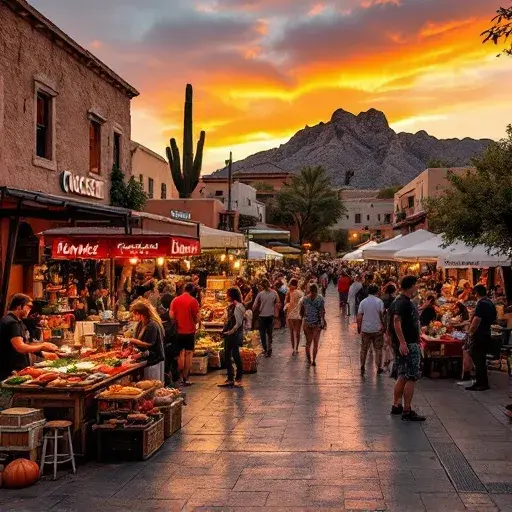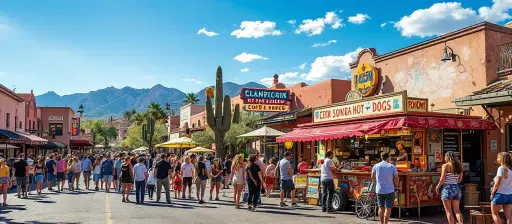Desert Delights: A Culinary and Cultural Journey Through Tucson, Arizona

Nestled in the Sonoran Desert and surrounded by five mountain ranges, Tucson, Arizona offers a unique blend of natural beauty, rich cultural heritage, and a surprisingly vibrant food scene. This desert gem boasts over 4,000 years of continuous human habitation, with influences from Native American, Spanish, Mexican, and American settlers creating a tapestry of traditions that's evident in everything from the architecture to the cuisine. In 2015, Tucson earned the prestigious designation as the first UNESCO City of Gastronomy in the United States, recognizing its remarkable food heritage and thriving culinary innovation. With its stunning desert landscapes, vibrant arts scene, and mouth-watering Southwestern flavors, Tucson invites visitors to explore a destination where ancient traditions meet contemporary creativity.

Introduction
Nestled in the Sonoran Desert and surrounded by five mountain ranges, Tucson, Arizona offers a unique blend of natural beauty, rich cultural heritage, and a surprisingly vibrant food scene. This desert gem boasts over 4,000 years of continuous human habitation, with influences from Native American, Spanish, Mexican, and American settlers creating a tapestry of traditions that's evident in everything from the architecture to the cuisine. In 2015, Tucson earned the prestigious designation as the first UNESCO City of Gastronomy in the United States, recognizing its remarkable food heritage and thriving culinary innovation. With its stunning desert landscapes, vibrant arts scene, and mouth-watering Southwestern flavors, Tucson invites visitors to explore a destination where ancient traditions meet contemporary creativity.
Overview of the Food Scene
Tucson's food scene is a delicious reflection of its multicultural heritage, with a strong emphasis on Sonoran Desert ingredients and Mexican influences. The city's culinary identity is deeply rooted in its "23 miles of Mexican food" – a stretch along 12th Avenue that offers some of the most authentic Mexican cuisine north of the border. Here, you'll find everything from street tacos and Sonoran hot dogs (bacon-wrapped and topped with beans, onions, tomatoes, and a variety of condiments) to sophisticated interpretations of traditional dishes using indigenous ingredients.
What truly sets Tucson apart is its commitment to preserving and celebrating native foods. The region's desert-adapted ingredients – including prickly pear, mesquite, cholla buds, and tepary beans – feature prominently in local cuisine. Organizations like Native Seeds/SEARCH and the Mission Garden project work to preserve these heritage foods, while innovative chefs incorporate them into contemporary dishes. The farm-to-table movement thrives here, with many restaurants sourcing ingredients from local producers who have adapted sustainable farming practices to the desert environment.
Beyond Mexican and Native American influences, Tucson's dining scene has expanded to include everything from upscale New American cuisine to international flavors, craft breweries, and award-winning wineries. The city's food festivals, farmers markets, and cooking classes offer visitors numerous opportunities to engage with the local food culture, making it a true paradise for culinary adventurers.
Where to Eat
Breakfast with a View
Start your culinary journey at Prep & Pastry, a beloved local breakfast spot known for its house-made pastries and creative morning fare. Try their duck confit hash or brioche French toast while enjoying the patio seating. For something with southwestern flair, head to Cup Cafe in the historic Hotel Congress, where the cast iron baked eggs and chilaquiles shine. If you're looking for a quick but quality breakfast, 5 Points Market & Restaurant offers farm-fresh ingredients in a casual setting, with their avocado toast and huevos rancheros being local favorites.
Downtown Dining Discoveries
For lunch, explore downtown Tucson's revitalized food scene. Cafe Poca Cosa (if it has reopened) offers sophisticated Mexican cuisine with a menu that changes twice daily based on market availability. Chef Suzana Davila's creative dishes showcase the depth and complexity of authentic Mexican flavors. Nearby, BOCA Tacos y Tequila features innovative tacos with unusual ingredients and house-made salsas that range from mild to wildly spicy. For a taste of Tucson's UNESCO designation in action, visit Exo Roast Co., where coffee is roasted in-house and the menu includes mesquite-flour pastries and chiltepín-infused cold brew.
Desert-Inspired Dining
For dinner, experience how Tucson chefs are reimagining desert cuisine. Maynards Market & Kitchen offers sophisticated fare using local ingredients in a historic train depot setting. Their seasonal menu might include prickly pear-glazed duck or locally foraged mushroom risotto. At The Coronet, the brasserie-style menu features Mediterranean influences with Arizona touches in a charming historic building. For a special occasion, The Grill at Hacienda Del Sol provides stunning mountain views alongside upscale Southwestern cuisine and an award-winning wine list.
Street Food and Casual Bites
No visit to Tucson is complete without sampling its famous Sonoran hot dogs. El Güero Canelo, a James Beard Award winner, serves the definitive version of this local specialty. For more casual Mexican fare, Seis Kitchen offers dishes representing six culinary regions of Mexico. If you're exploring the university area, stop by Time Market for wood-fired pizzas and artisanal sandwiches in a hip market setting. And for dessert, cool off with creative gelato flavors at Isabella's Ice Cream, where they make small batches using local ingredients like mesquite, prickly pear, and Sonoran honey.
What to Do
Desert Exploration
Tucson is surrounded by natural beauty that begs to be explored. Saguaro National Park flanks the city on both east and west sides, offering close encounters with the iconic saguaro cactus and miles of hiking trails suitable for all levels. The park is particularly magical at sunrise or sunset when the desert light creates a stunning backdrop for photography. For a more immersive desert experience, visit the world-renowned Arizona-Sonora Desert Museum, which combines a zoo, botanical garden, natural history museum, and art gallery in one fascinating location. With 85% of its exhibits outdoors, it provides an authentic introduction to desert ecology.
For a refreshing contrast to the desert heat, explore Sabino Canyon in the Santa Catalina Mountains. This lush oasis features a tram that takes visitors deep into the canyon, where seasonal streams create pools perfect for cooling off. Hikers can enjoy numerous trails, including the popular Seven Falls path that leads to a series of natural swimming holes (when water is flowing).
Cultural Immersion
Tucson's rich cultural heritage is on display throughout the city. Begin at Mission San Xavier del Bac, an 18th-century Spanish colonial mission often called the "White Dove of the Desert." Its stunning white façade and intricate interior artwork make it one of the finest examples of Spanish colonial architecture in the United States. Continue your historical exploration at Presidio San Agustín del Tucson Museum, a reconstruction of the original Tucson presidio built in 1775, which offers insights into the city's Spanish colonial past.
Art enthusiasts should visit the Tucson Museum of Art in the historic El Presidio neighborhood, featuring extensive collections of Latin American, Western, and contemporary art. Nearby, the DeGrazia Gallery in the Sun showcases the work of iconic Arizona artist Ted DeGrazia in a unique adobe complex he designed and built himself.
Culinary Adventures
Given Tucson's UNESCO City of Gastronomy status, food-focused activities are a must. Take a self-guided tour of the Mission Garden, a living agricultural museum that recreates 4,000 years of Tucson's farming history, growing heritage crops that have sustained the region's inhabitants for millennia. Time your visit to coincide with the Heirloom Farmers Markets, where local producers showcase the bounty of the Sonoran Desert alongside artisanal food products.
For a hands-on experience, book a cooking class at The Carriage House, where renowned chef Janos Wilder offers instruction in preparing Southwestern cuisine using local ingredients. Wine enthusiasts can take a day trip to nearby Sonoita-Elgin Wine Country, Arizona's premier wine region, where high-altitude vineyards produce surprisingly excellent wines in the desert.
Off the Beaten Path
For a unique Tucson experience, visit the Valley of the Moon, a whimsical folk art fantasy land built in the 1920s that hosts magical theatrical experiences. Architecture buffs should explore Barrio Viejo, one of Tucson's oldest neighborhoods, known for its colorful adobe homes and Hispanic heritage. For a glimpse into the future (and past) of astronomy, take an evening tour of Kitt Peak National Observatory or the Mt. Lemmon SkyCenter, where some of the world's most powerful telescopes offer breathtaking views of the night sky – a fitting end to days spent in the clear desert air.
Where to Stay
Downtown/University Area
For visitors focused on Tucson's urban attractions and dining scene, downtown offers the perfect base. The revitalized city center is home to historic properties like Hotel Congress, a landmark since 1919 with a rock 'n' roll history and lively nightlife. For more upscale accommodations, The Downtown Clifton boutique hotel offers mid-century modern style with a distinctly Tucson twist. This area puts you within walking distance of many restaurants, museums, and the streetcar line that connects to the University of Arizona campus, where you'll find additional dining options and cultural attractions.
Foothills/Resort Corridor
If you prefer luxury accommodations with desert views, Tucson's northern foothills area is ideal. Historic properties like Hacienda Del Sol Guest Ranch Resort offer Spanish colonial charm and spectacular mountain vistas, while Loews Ventana Canyon Resort and The Westin La Paloma Resort & Spa provide upscale amenities including championship golf courses, spa facilities, and multiple dining options. Staying in this area puts you closer to Sabino Canyon, the Arizona-Sonora Desert Museum, and some of Tucson's finest restaurants, though you'll want a car to explore the city fully.
Central Tucson
For a balance of convenience and character, consider central Tucson neighborhoods like Sam Hughes or El Presidio. Here, vacation rentals and bed-and-breakfasts like the historic Sam Hughes Inn offer a more residential experience in walkable areas with easy access to both downtown and the foothills attractions. This central location is particularly convenient for culinary explorers, as it provides quick access to restaurants throughout the city while offering a glimpse into local life beyond the tourist areas.
Conclusion
Tucson offers a rare combination of natural beauty, cultural depth, and culinary excellence that rewards curious travelers. Beyond the stunning desert landscapes and rich history, it's the city's commitment to preserving and reimagining its food heritage that truly sets it apart. From ancient agricultural traditions to innovative desert cuisine, from historic adobes to world-class museums, Tucson invites visitors to slow down and savor experiences that can't be found elsewhere. Whether you're hiking among towering saguaros, sampling heritage ingredients in creative dishes, or simply enjoying the spectacular sunset colors against mountain silhouettes, Tucson's distinctive Southwestern charm creates memories that linger long after the desert dust has been shaken from your shoes. Come hungry, stay curious, and discover why this desert city has captured the hearts of food lovers and cultural explorers alike.